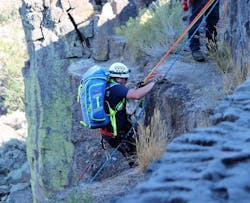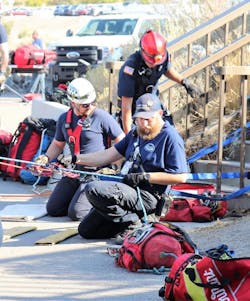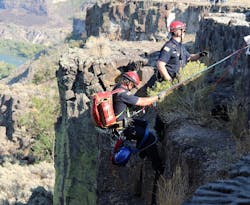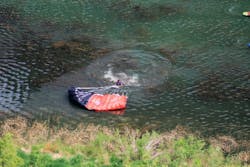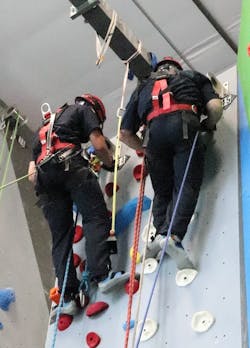Every day, emergency service providers strive to deliver better customer service to the citizens who they serve. These agencies also search for methods by which they can “do more with less.”
Three organizations in and near to Twin Falls, ID, are no different.
At first, these emergency service providers attempted to fill a void by forming separate rope rescue teams. However, as the number of rope rescues increased, a duplication of efforts was recognized. The agencies joined forces and now provide a better product. Other agencies throughout the United States should consider utilizing this model as they, too, try to do more with less.
The city of Twin Falls
Twin Falls has a population of more than 53,000 people. The city is located in southern Idaho on the edge of the Snake River Canyon in Twin Falls County (1,928 square miles). On the canyon’s eastern edge is Shoshone Falls, which often is referred to as the Niagara of the West. Shoshone Falls is 212 feet tall and 900 feet wide, which makes it one of the largest waterfalls in the United States—and larger than Niagara Falls.
Twin Falls is a destination for BASE jumpers, as they head to Perrine Bridge, which is one of the few places where BASE jumping is allowed without a permit. BASE jumpers jump from the bridge and land 486 feet below it. Almost every day, weather permitting, BASE jumpers jump from the bridge.
In general, since the first recorded BASE jump in 1981, there have been 462 fatalities worldwide. Eleven of those fatalities occurred at the Perrine Bridge. In addition, one jumper drowned in the Snake River after attempting to swim across the river after a successful jump, and another jumper became lost and succumbed to hyperthermia trying to exit the canyon after dark.
Twin Falls Fire Department
The Twin Falls Fire Department (TFFD), which is under the leadership of Fire Chief Les Kenworthy, responds out of four stations that are staffed 24/7. Forty-nine firefighters perform operations, fire prevention and other department activities. In 2022, the department responded to 6,436 requests for services.
Engine 1 is staffed by four firefighters and cross-staffs the department’s ladder truck. Engine 2 and Engine 3 are staffed by three firefighters each. Station 4 is located at Twin Falls Airport and is staffed by a driver/operator. Each of the three shifts is commanded by a battalion chief who reports to the department’s deputy chief.The driving force behind the TFFD’s formation of its technical rescue team was the need to respond to confined-space rescue scenarios at various industries within the department’s jurisdiction and to better support other city services. Department administrators also recognized the need for a capability to address high-angle/rope rescue incidents, particularly within the many canyons and other geological features that are in the area.
Today, every member of the TFFD is trained to the rope operations level. Twelve members are trained to the rope technician level I or II and serve as the rope rescue team.
The department strives to always keep four rope technicians on duty. When backfilling for vacations and sick days, this can be challenging. Should a rope rescue incident be received and four rope technicians aren’t on duty, department procedure initiates an emergency call-back of rope technicians to fill out the team.
In addition to regular firefighter duties, each of the 12 rope technicians is assigned to various committees within the technical rescue team. These committees’ responsibilities include task areas, such as training and equipment acquisition. As an example, members of the purchasing committee identify new equipment to be purchased and then submit the purchase request through department channels.
The technical rescue team conducts at least one rescue-dedicated training event per month. These training sessions rotate through the various aspects of technical rescue, including rope rescue and confined-space rescue.
In the past, the team conducted rope rescue training at Gemstone Climbing Center. Now, most of the training is conducted at the department’s training tower. In addition, the team regularly trains in the local canyons and geological features. The decision to train in these areas helps the rope rescue technicians to better prepare for rescues in those areas, which are popular with rock climbers.
In addition to in-house training, the team trains with other agencies, such as the Jerome, ID, Fire Department’s technical rescue team, the Magic Valley Paramedics’ Special Operations Reach and Treat (SORT) team, and the Twin Falls County Sheriff’s Office Search and Rescue (SAR) team.
TFFD’s rope rescue team responds with a rescue vehicle that carries all of the department’s technical rescue gear. This apparatus is assigned to Station 2 and is cross-staffed with the Engine 2 crew.The department added two 600-foot static rescue ropes to its equipment cache. These longer ropes allow for the rope technicians to better access the areas within some of the canyons that are in the response area.
What makes the TFFD’s rope rescue team unique when compared with teams in other departments is that it averages at least one response per month to a canyon. These calls include rock climbers who are stuck on a canyon wall, tourists who get too close to the edge of a canyon and fall into the canyon and BASE jumpers who miss the landing area in the bottom of the Snake River Canyon.
Calls also include people who attempt to commit suicide by jumping off of the bridge. On average, the rope teams respond to more suicides than BASE jumper incidents. When the communication centers receive a report of someone who jumped off of the bridge, the first question that call-takers ask the reporting party is whether the jumper was wearing a helmet and backpack, which are indicators that the jumper is a BASE jumper.
A close working relationship with the Magic Valley Paramedics SORT team and the Twin Falls County Sheriff’s Office SAR team is vital. Each agency has resources that the other agencies might lack. For example, the Twin Falls County Sheriff’s Office SAR team has boats. Also, Magic Valley Paramedics SORT paramedics play a significant role in treating patients early in the rescue operation, which increases patients’ chances for survival.
Another valuable asset at the disposal of the incident commander at a rope rescue in one of the canyons is the area’s air ambulances. Air St. Luke’s and Life Flight provide these helicopters. The Air St. Luke’s helicopter proved its value on rescues many times when the flight crew utilized its forward-looking infrared (FLIR) to help to locate victims during night rescues in the canyons. (The thermal imaging cameras that are used by firefighters also work but aren’t as effective as the FLIR that’s on the helicopters.)SAR
The responsibility for search and rescue falls to the Twin Falls County Sheriff’s Office. Its SAR team was organized in the early 1970s. It’s staffed with four full-time deputies and 45 volunteers. Ten of the volunteers received additional training in rope rescue and serve on the rappel team.
When responding to an incident, the SAR team members receive no compensation. They must provide their own fuel for their vehicle. In the event of an extended incident, the sheriff’s department provides the second tank of fuel for the volunteer’s vehicle, if the vehicle is required to be a part of the rescue.
To be a member of the Twin Falls County Sheriff’s Office SAR team, prospective candidates must pass a thorough background check. Once individuals pass the background check, they must attend SAR meetings and training events regularly. Training events are held at least twice per month.
Volunteers who wish to join the rappel team must receive the endorsement of the members of the rappel team.
The SAR team also takes search and rescue K-9s rappelling as part of the dogs’ training. This training works both ways: The SAR team can rescue dogs from a canyon if the rescue doesn’t place the SAR team member at risk.
Members of the rappel team have their own equipment pack, which they must maintain. This allows members to respond directly to an incident.
All of the rope rescue equipment, including the individual equipment packs, are purchased by the SAR team, although the team receives no funding from the sheriff’s office for equipment. Thus, the team regularly holds fundraisers to purchase new equipment.
All other rope rescue equipment is kept in a trailer that can be towed to the incident scene by a sheriff’s office vehicle. Included in this trailer are four 600-foot-length ropes and TerrAdaptor tripod systems for use in the Snake River Canyon.
A “light trailer” includes a generator and lighting equipment.SORT
Magic Valley Paramedics is a hospital-based team that provides emergency medical services for the Twin Falls County as well as neighboring counties. With a team of 75 employees, the agency responds annually to more than 13,500 requests for medical assistance, including an average of 22 rope rescues per year.
In 1996, Magic Valley Paramedics formed its SORT team to respond to low- and high-angle rescues within its response areas. The SORT team is considered to be a regional rope rescue team. It responds to incidents in a large geographical area. It responded to incidents as far away as Elko, NV (165 miles away). It isn’t uncommon for the SORT team to respond to incidents that are an hour away by helicopter.
For these long-distance responses, the team partnered with Air St. Luke’s, which utilizes a Bell 429 air ambulance. Pilots maintain a list of SORT team members and their weight. In addition, SORT has several prepackaged equipment bags. Each bag is numbered, and pilots have a list of these numbers and the weight of the bag. With this information, pilots can determine what they can and can’t fly with. The goal is to get the SORT team launched in the helicopter in fewer than 10 minutes.
The team’s 20 members are trained as EMTs and paramedics as well as rope rescue technician I and rope rescue technician II.
Training is conducted in-house. Members of SORT are trained initially to rope technician level I. After one year, they can be upgraded to rope rescue technician II, assuming that the training requirements were met. The training is led by five members of SORT who are instructors for Idaho Fire Service Training through College of Eastern Idaho.
The SORT team also manages a unique training program. Four area fire departments each have a member who is trained in rope rescue. When the SORT team receives a call, these four firefighters respond. They receive no compensation from Magic Valley Paramedics. For liability purposes, they are considered “on-duty” with their department when they respond with the SORT team. This program allows these firefighters to take valuable skills and experiences back to their home department.
The four departments that are represented in this program are the Buhl Fire Department, the Gooding Fire District, the Jerome Fire Department and the Rock Creek Fire District.
Once selected to be a member of the SORT team, members must then participate in eight hours of training per month. Because the TFFD and the Twin Falls County Sheriff’s Office SAR team basically use the same training program, which was developed by the SORT team, members of the SORT team who miss a training event that’s held with Magic Valley Paramedics can make up the training by attending the training event of one of the other agencies.At a minimum, each member is required to attend at least 75 percent of the training events. In addition, each member must pass an annual skills validation test.
Magic Valley Paramedics strives to have at least two SORT team members on duty every shift. Both are assigned to the same ambulance. This allows them to respond to medical calls and, if a SORT response is dispatched, to return to headquarters to retrieve the SORT equipment truck to respond to the incident.
Like the SAR team, the equipment that’s used by the SORT team for rope rescue is purchased with monies that are collected at fundraising events.
As for special equipment, the SORT team responds with four 700-foot 11 mm ropes, five 300-foot ropes, two 400-foot ropes, an Arizona Vortex and a TerrAdaptor tripod system.
Once on scene, it’s the goal of the SORT team to have at least one paramedic over the side and treating the injured party within 10 minutes. This is accomplished with a basic rope system. As more rescuers arrive, more substantial rope systems are set up.
Because all three agencies are familiar with each other’s equipment—in many cases, it’s the same equipment—the equipment off of the first-arriving vehicle is used, which allows any additional vehicles that are on scene to remain in service should there be a second rope rescue incident.
On scene
Arriving at a rope rescue incident that’s within the city limits of Twin Falls, particularly one in a canyon, the on-duty battalion chief from the TFFD assumes command. If the incident is located outside of the city limits, the SAR rappel team assumes command. If the party to be rescued is injured, the SORT team assumes command. Once all of these agencies are on scene, command transitions into a unified command.
For some rescues, part of the rescue team might be transported up the Snake River by boat, while other members are lowered over the side of the canyon to start treatment of the patient. This is beneficial for situations when it might be in everyone’s best interest to lower a patient to the canyon floor rather than hoist the patient along the wall to the top.
It’s important to note that the leaders of the three teams meet every quarter to discuss recent incidents and other items of interest that will enhance their working relationship.
Part of something larger
“Sharing” is a word that often is heard among the rope rescue teams in and near to Twin Falls, and sharing is very evident when one considers that these teams not only train and work with each other but also work closely with other area emergency services, that they share their expertise with other rope rescue teams throughout the region and that they respond to rescues more than 100 miles away.
Thank you to TFFD Deputy Fire Chief Mitchell Brooks and Battalion Chief Aaron Hudson, Lt. Daron Brown of the Twin Falls County Sheriff’s Office and Magic Valley Paramedics supervisors Chad Smith and Brian Stone.
Courageous Kids Climbing
Courageous Kids Climbing is a nonprofit that provides free opportunities for people who have special needs to experience various forms of rock climbing at events throughout the western United States. First responders support most of these events, seizing the opportunity to not only enhance their skills for working with people who have special needs but also getting rope rescue skills and team-building practice.
The first annual event in Twin Falls, ID, which was supported by the Twin Falls Fire Department (TFFD), occurred on Oct. 6, 2018. In 2021, the event became a semiannual event. The TFFD has supported eight events, with nearly 100 people who have special needs coming out. These events also are supported by Magic Valley Paramedics’ Special Operations Reach and Treat (SORT) team and the Twin Falls County Sheriff’s Office Search and Rescue (SAR) team.
Firefighters support the events by belaying the climbers and, in many instances, by setting up a 4:1 haul system. This system is used to raise the climbing wall participants who are physically challenged. For younger participants who might not yet have overcome their fear of heights, firefighters climb alongside the participants, offering words of encouragement.
About the Author

Jeff Riechmann
Jeff Riechmann is retired from the Kern County, CA, Fire Department, where he served as a firefighter for 23 years. Riechmann also retired from the U.S. Air Force Reserve as a deputy fire chief. He has taught fire technology and fire science at the college level. Riechmann can be reached at [email protected].
